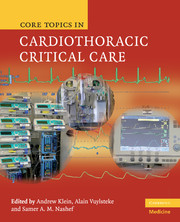26 results
Chapter 1 - Basic Principles of Cardiac Surgery
- from Section 1 - Routine Cardiac Surgery
-
-
- Book:
- Core Topics in Cardiac Anaesthesia
- Published online:
- 12 May 2020
- Print publication:
- 23 April 2020, pp 1-5
-
- Chapter
- Export citation
Contributors
-
-
- Book:
- Core Topics in Cardiac Anesthesia
- Published online:
- 05 April 2012
- Print publication:
- 15 March 2012, pp x-xiii
-
- Chapter
- Export citation
Chapter 18 - Basic principles of cardiac surgery
- from Section 4 - Cardiac surgery for anesthesiologists
-
-
- Book:
- Core Topics in Cardiac Anesthesia
- Published online:
- 05 April 2012
- Print publication:
- 15 March 2012, pp 108-112
-
- Chapter
- Export citation
Chapter 17 - Patient selection and risk stratification
- from Section 4 - Cardiac surgery for anesthesiologists
-
-
- Book:
- Core Topics in Cardiac Anesthesia
- Published online:
- 05 April 2012
- Print publication:
- 15 March 2012, pp 103-107
-
- Chapter
- Export citation
SECTION 6 - Structure and Organisation in Cardiothoracic Critical Care
-
- Book:
- Core Topics in Cardiothoracic Critical Care
- Published online:
- 05 July 2014
- Print publication:
- 13 March 2008, pp 451-452
-
- Chapter
- Export citation
3.3 - RENAL SYSTEM IN CARDIOTHORACIC CRITICAL CARE
- from SECTION 3 - System Management in Cardiothoracic Critical Care
-
- Book:
- Core Topics in Cardiothoracic Critical Care
- Published online:
- 05 July 2014
- Print publication:
- 13 March 2008, pp 221-222
-
- Chapter
- Export citation
3.2 - RESPIRATORY SYSTEM IN CARDIOTHORACIC CRITICAL CARE
- from SECTION 3 - System Management in Cardiothoracic Critical Care
-
- Book:
- Core Topics in Cardiothoracic Critical Care
- Published online:
- 05 July 2014
- Print publication:
- 13 March 2008, pp 181-182
-
- Chapter
- Export citation
SECTION 5 - Discharge and Follow-up From Cardiothoracic Critical Care
-
- Book:
- Core Topics in Cardiothoracic Critical Care
- Published online:
- 05 July 2014
- Print publication:
- 13 March 2008, pp 431-432
-
- Chapter
- Export citation
SECTION 1 - Admission to Critical Care
-
- Book:
- Core Topics in Cardiothoracic Critical Care
- Published online:
- 05 July 2014
- Print publication:
- 13 March 2008, pp 1-2
-
- Chapter
- Export citation
SECTION 3 - System Management in Cardiothoracic Critical Care
-
- Book:
- Core Topics in Cardiothoracic Critical Care
- Published online:
- 05 July 2014
- Print publication:
- 13 March 2008, pp 135-136
-
- Chapter
- Export citation
Appendix Works Cited
-
- Book:
- Core Topics in Cardiothoracic Critical Care
- Published online:
- 05 July 2014
- Print publication:
- 13 March 2008, pp 517-518
-
- Chapter
- Export citation
SECTION 7 - Ethics, Legal Issues and Research in Cardiothoracic Critical Care
-
- Book:
- Core Topics in Cardiothoracic Critical Care
- Published online:
- 05 July 2014
- Print publication:
- 13 March 2008, pp 491-492
-
- Chapter
- Export citation
3.8 - NEUROLOGICAL SYSTEM IN CARDIOTHORACIC CRITICAL CARE
- from SECTION 3 - System Management in Cardiothoracic Critical Care
-
- Book:
- Core Topics in Cardiothoracic Critical Care
- Published online:
- 05 July 2014
- Print publication:
- 13 March 2008, pp 343-344
-
- Chapter
- Export citation

Core Topics in Cardiothoracic Critical Care
-
- Published online:
- 05 July 2014
- Print publication:
- 13 March 2008
SECTION 4 - Procedure-Specific Care in Cardiothoracic Critical Care
-
- Book:
- Core Topics in Cardiothoracic Critical Care
- Published online:
- 05 July 2014
- Print publication:
- 13 March 2008, pp 369-370
-
- Chapter
- Export citation
Abbreviations
-
- Book:
- Core Topics in Cardiothoracic Critical Care
- Published online:
- 05 July 2014
- Print publication:
- 13 March 2008, pp xix-xxiv
-
- Chapter
- Export citation
Contributors
-
- Book:
- Core Topics in Cardiothoracic Critical Care
- Published online:
- 05 July 2014
- Print publication:
- 13 March 2008, pp x-xv
-
- Chapter
- Export citation
3.6 - IMMUNE SYSTEM AND INFECTION IN CARDIOTHORACIC CRITICAL CARE
- from SECTION 3 - System Management in Cardiothoracic Critical Care
-
- Book:
- Core Topics in Cardiothoracic Critical Care
- Published online:
- 05 July 2014
- Print publication:
- 13 March 2008, pp 299-300
-
- Chapter
- Export citation
Index
-
- Book:
- Core Topics in Cardiothoracic Critical Care
- Published online:
- 05 July 2014
- Print publication:
- 13 March 2008, pp 519-540
-
- Chapter
- Export citation
3.5 - GASTROINTESTINAL SYSTEM IN CARDIOTHORACIC CRITICAL CARE
- from SECTION 3 - System Management in Cardiothoracic Critical Care
-
- Book:
- Core Topics in Cardiothoracic Critical Care
- Published online:
- 05 July 2014
- Print publication:
- 13 March 2008, pp 267-268
-
- Chapter
- Export citation

